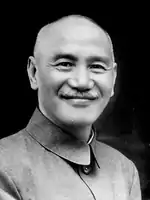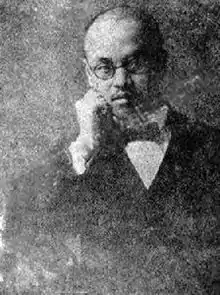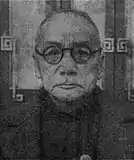1947 Chinese National Assembly election
The 1947 Chinese National Assembly election was held between 21 and 23 November 1947 in China. This is the first election of under the newly ratified 1947 Constitution of the Republic of China. Under this constitution, the National Assembly is an authoritative legislature body that holds the power as constitutional convention and presidential electoral college. A total of 2,961 delegates were elected from across the country.[1]
| |||||||||||||||||||||
3,045 seats to the National Assembly | |||||||||||||||||||||
|---|---|---|---|---|---|---|---|---|---|---|---|---|---|---|---|---|---|---|---|---|---|
| |||||||||||||||||||||
Overview
The election was organized by the Kuomintang-led Nationalist government. Elected National Assembly delegates started its first session on March 29, 1948 in Nanking. The inauguration of the first National Assembly marks the transition of China into constitutional governance. Chiang Kai-shek, the leader of the Nationalist government, was elected by the National Assembly delegates in the later presidential election to be the first President of the Republic of China in the constitutional government.
However, the Kuomintang-led Government of the Republic of China lost the Chinese Civil War in the next year of 1949. This resulted the government to retreat to Taiwan. Around half of the National Assembly delegates came to Taiwan with the government. Since the government had lost control over mainland China. The delegates extended their own terms until "re-election is possible in their original electoral district." This situation remained until an Constitutional Court (Judicial Yuan) decision in June 1991 that orders the terms to terminate by the end of 1991.
The National Assembly delegates elected actually served in office from March 29, 1948 to December 31, 1991, which equals 43 years and 278 days.
Seats and results
Seats breakdown
In principle, the electoral districts were designed to elect one delegate for each county or equivalent of China. China recognized the result of the 1945 Mongolian independence referendum, hence this election only held in the Mongolian leagues and banners within provinces of China, which roughly equals the territory of Inner Mongolia. The Tibetan electoral districts includes the Tibet Area as well as the Tibetan regions within provinces of China. Most of Tibet were controlled by semi-independent Kashag government at this time.
| Electoral district type | Seats | Delegates | ||
|---|---|---|---|---|
| elected | not elected | |||
| Counties, cities, and equivalents | 2,177 | 2,141 | 36 | |
| Inner Mongolia | 57 | 57 | 0 | |
| Tibet | 40 | 39 | 1 | |
| Minority ethnic groups in frontier area | 34 | 34 | 0 | |
| Overseas Chinese | 65 | 22 | 43 | |
| Occupational groups | Regional | 216 | 216 | 0 |
| Nationwide | 271 | 268 | 3 | |
| Women groups | Regional | 148 | 147 | 1 |
| Nationwide | 20 | 20 | 0 | |
| Nationals in China proper with special convention | 17 | 17 | 0 | |
| Total | 3,045 | 2,961 | 84 | |
Results in Taiwan
Taiwan was under Japanese rule before August 15, 1945. Before World War II, few Taiwanese people were selected by the Government of Japan to participate the Imperial Diet. As a result of World War II, the Republic of China Armed Forces occupied Taiwan on behalf of the Allies. The government established Taiwan Province to mark its annexation of Taiwan.
The administrative divisions of Taiwan consist of 8 counties and 9 cities. However, an additional delegate seat were added to Taichung County and Tainan County respectively due to their population. There were 19 delegates elected in this election.
| Party | Votes | % | Seats |
|---|---|---|---|
| Valid votes | 1,925,739 | 100 | 19 |
| Invalid/blank votes | 33,415 | – | – |
| Total | 1,959,154 | 100 | 19 |
| Source: Nohlen et al. | |||
Related elections
Previous and next legislative elections
There were some regime changes happened in China during the first half of the 20th century. Depends on the definition, possible previous and next elections for legislatures with similar functions are listed below.
| Order | Election | Political entity | Note |
|---|---|---|---|
| Previous | 1918 Chinese National Assembly election | Elected the 2nd National Assembly under the Beiyang government | |
| Next | 1954 Chinese congressional election | Elected the 1st National People's Congress | |
| 1969 Taiwanese legislative election | Elected supplementary delegates served together with the 1st National Assembly | ||
| 1991 Taiwanese National Assembly election | Elected new delegates to form the 2nd National Assembly |
Presidential elections in National Assembly
The government of the Republic of China claims the sovereignty over the whole China. However, due to the inability to hold re-elections in mainland China after 1949, the National Assembly delegates elected in 1947 still held elections in Taiwan to elect the President and Vice President every 6 years in accordance with the constitution. This situation remained until the democratization took place in Taiwan in the 1990s under the Lee Teng-hui administration.
| Order | Presidential Election | Voting delegates | President | Vice President |
|---|---|---|---|---|
| 1st | 1948 Chinese presidential election | 1947 | Chiang Kai-shek | Li Tsung-jen |
| 2nd | 1954 Taiwanese presidential election | 1947 | Chiang Kai-shek | Chen Cheng |
| 3rd | 1960 Taiwanese presidential election | 1947 | Chiang Kai-shek | Chen Cheng |
| 4th | 1966 Taiwanese presidential election | 1947 | Chiang Kai-shek | Yen Chia-kan |
| 5th | 1972 Taiwanese presidential election | 1947, 1969 | Chiang Kai-shek | Yen Chia-kan |
| 6th | 1978 Taiwanese presidential election | 1947, 1969, 1972 | Chiang Ching-kuo | Hsieh Tung-min |
| 7th | 1984 Taiwanese presidential election | 1947, 1969, 1980 | Chiang Ching-kuo | Lee Teng-hui |
| 8th | 1990 Taiwanese presidential election | 1947, 1969, 1986 | Lee Teng-hui | Lee Yuan-tsu |
See also
References
- Dieter Nohlen, Florian Grotz & Christof Hartmann (2001) Elections in Asia: A data handbook, Volume II, p548 ISBN 0-19-924959-8



